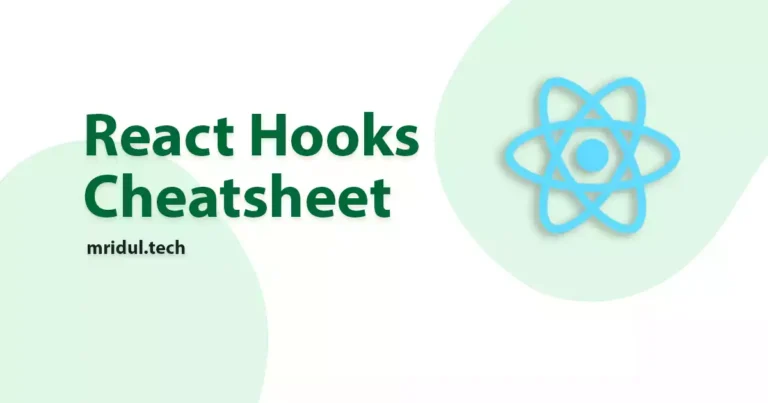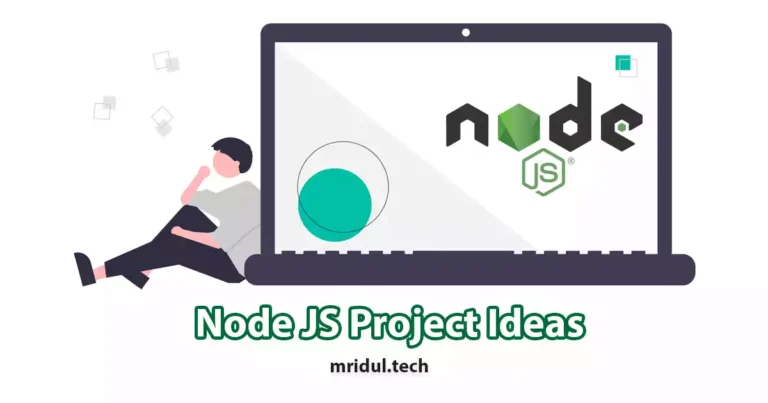The Modern Web Stacks You Should Know About
Mridul Panda
Jul 03, 2023
·6 Min Read

In today’s digital age, web development has become an integral part of businesses and organizations worldwide. To create robust and efficient web applications, developers rely on a combination of technologies known as web stacks. A web stack is a set of software tools and frameworks that work together to enable the development, deployment, and maintenance of web applications. In this article, we will explore some popular web stacks that every aspiring web developer should know about.
Web Stacks You Should Know About
Web stacks, also known as tech stacks or software stacks, are combinations of programming languages, frameworks, libraries, and tools that work together to build and deploy web applications. Each web stack has its strengths and weaknesses, catering to different project requirements and developer preferences. Let’s delve into some of the most influential web stacks you should be familiar with.
1. MERN Stack
Full-Form: MongoDB + Express.js + React JS + Node.js
The MERN stack is a powerful combination of technologies that includes MongoDB, Express.js, ReactJS, and Node.js. MongoDB is a NoSQL database that provides scalability and flexibility for handling large amounts of data. Express.js is a fast and minimalist web application framework for Node.js, which allows you to build robust and scalable web applications. ReactJS is a JavaScript library for building user interfaces, offering a component-based approach and efficient rendering. Node.js is a JavaScript runtime that enables server-side development. Together, these technologies provide a full-stack JavaScript solution for building modern web applications.
Also Read: 10 React Project Ideas to Boost Your Portfolio
2. MEAN Stack
Full-Form: MongoDB + Express.js + Angular JS + Node.js
Similar to the MERN stack, the MEAN stack is another popular choice for web development. MEAN stands for MongoDB, Express.js, AngularJS, and Node.js. MongoDB serves as the database, Express.js is the web application framework, AngularJS is a JavaScript framework for building dynamic web applications, and Node.js handles server-side logic. The MEAN stack offers a seamless integration between the frontend and backend, making it an efficient choice for developing full-stack JavaScript applications.
3. MEVN Stack
Full-Form: MongoDB + Express.js + Vue.js + Node.js
The MEVN stack is a variant of the MEAN stack, with Vue.js replacing AngularJS as the frontend framework. MEVN stands for MongoDB, Express.js, Vue.js, and Node.js. Vue.js is a progressive JavaScript framework that focuses on simplicity and ease of use. It allows developers to build interactive user interfaces and single-page applications. The MEVN stack provides a lightweight and flexible solution for building modern web applications using JavaScript.
4. LAMP Stack
Full-Form: Linux + Apache + MySQL + PHP
The LAMP stack has been a popular choice for web development for many years. LAMP stands for Linux, Apache, MySQL, and PHP. Linux serves as the operating system, Apache is the web server, MySQL is the database management system, and PHP is the server-side scripting language. The LAMP stack offers a reliable and stable environment for building dynamic web applications.
5. LEMP Stack
Full-Form: Linux + Nginx + MySQL + PHP
The LEMP stack is similar to the LAMP stack but replaces Apache with Nginx as the web server. LEMP stands for Linux, Nginx, MySQL, and PHP. Nginx is known for its high performance, scalability, and ability to handle a large number of concurrent connections. The LEMP stack is particularly suitable for high-traffic websites and applications where performance is a critical factor.
6. WAMP Stack
Full-Form: Windows + Apache + MySQL + PHP
WAMP stack is a web stack that is commonly used on Windows systems. WAMP stands for Windows, Apache, MySQL, and PHP. It provides a local development environment for building web applications on a Windows operating system. The WAMP stack is easy to set up and is widely used by developers who prefer working on Windows machines.
7. JAM Stack
Full-Form: JavaScript + APIs + Markup
JAMstack stands for JavaScript, APIs, and Markup. It is a modern approach to web development that focuses on building fast and secure websites and applications. In the JAMstack architecture, the front end is disconnected from the backend, and the content is served through APIs. This decoupling allows for better performance, scalability, and easier maintenance. The dynamic functionality is handled by JavaScript running on the client side, interacting with APIs to fetch data or perform serverless functions.
Also Read: Top 5 Free APIs for Your Next Project
8. WISA Stack
Full-Form: Windows + IIS + SQL Server + ASP dot NET
The WISA stack is a Microsoft-based web stack commonly used in Windows environments. WISA stands for Windows, IIS (Internet Information Services), SQL Server, and ASP.NET. Windows serves as the operating system, IIS is the web server, SQL Server is the database management system, and ASP.NET is the framework for building dynamic web applications. The WISA stack provides a comprehensive set of tools and technologies for developing web applications on the Windows platform.
9. Django Stack
Full-Form: Python + Django + PostgreSQL + Nginx
Django is a high-level Python web framework known for its simplicity and robustness. The Django stack consists of Django as the framework, Python as the programming language, PostgreSQL or other databases for data storage, and Nginx as the web server. Django follows the Model-View-Controller (MVC) architectural pattern, providing a clean and efficient way to develop web applications. It includes features such as authentication, security, and ORM (Object-Relational Mapping) for interacting with databases.
10. Ruby on Rails Stack
Full-Form: Ruby on Rails + PostgreSQL + Puma
Ruby on Rails, also known as Rails, is a popular web development framework written in Ruby. The Ruby on Rails stack includes Rails as the framework, Ruby as the programming language, and PostgreSQL as the preferred database management system. Rails follow the convention-over-configuration principle, emphasizing simplicity and developer productivity. It provides a robust set of tools and libraries for rapid application development, making it a favorite among startups and small businesses.
11. Flask Stack
Full-Form: Python + Flask + SQLite + Nginx
Flask is a lightweight Python web framework. The Flask stack includes Flask as the framework, Python as the programming language, SQLite or other databases for data storage, and Nginx as the web server. Flask is designed to be easy to use and allows developers to build web applications quickly. It provides modular components, URL routing, and a built-in development server, making it an excellent choice for small to medium-sized projects.
12. MERN + GraphQL Stack
Full-Form: MongoDB + Express.js + ReactJS + Node.js + GraphQL
The MERN stack can be enhanced with GraphQL, a query language for APIs. GraphQL allows developers to define the data requirements of their applications precisely. By integrating GraphQL into the MERN stack, developers can efficiently fetch data from multiple sources, optimize network requests, and eliminate over-fetching or under-fetching of data. GraphQL complements the MERN stack’s JavaScript-based ecosystem, providing a powerful and flexible solution for building data-driven web applications.
Conclusion
Web stacks are the foundation of modern web development, providing the necessary tools and technologies to create robust and scalable web applications. Each web stack offers unique features and advantages, catering to different project requirements and developer preferences. Whether you choose the MERN stack for JavaScript-centric development, the LAMP stack for a traditional approach, or the JAMstack for fast and secure websites, understanding these web stacks will empower you to build impressive web applications.
You may also like
10 FREE HTML CSS Template Websites

Mar 16, 2024
·3 Min Read
In the ever-evolving world of web design, having a solid foundation is key to creating visually appealing and functional websites. HTML and CSS are the building blocks of the web, and having access to free templates can save you both time and effort. In this article, we’ll introduce you to 10 FREE HTML CSS template […]
Read More
React Hooks Cheatsheet

Jan 21, 2024
·4 Min Read
React, a popular JavaScript library for building user interfaces, introduced Hooks to make functional components more powerful and expressive. Let’s dive into the React Hooks Cheatsheet to understand how they enhance the development experience. React Hooks Cheatsheet In the ever-evolving landscape of web development, React Hooks have become indispensable for building dynamic and efficient user […]
Read More
Free Udemy Courses for Web Developers

Dec 30, 2023
·4 Min Read
In the fast-paced world of web development, staying up-to-date with the latest technologies and skills is crucial. However, enrolling in courses can be expensive, and not everyone has the budget for it. This is where Free Udemy Courses for Web Developers come to the rescue. In this article, we’ll explore this invaluable resource, providing you […]
Read More
Discover the Top 5 Free ChatGPT Alternatives

Nov 26, 2023
·5 Min Read
In today’s digital age, artificial intelligence (AI) has revolutionized various aspects of our lives, including the way we communicate and interact online. One such AI model that gained significant popularity is ChatGPT. However, if you’re looking for free alternatives that offer similar functionalities and engaging experiences, you’re in the right place! In this blog post, […]
Read More
Node JS Project Ideas to Boost Your Portfolio

Sep 20, 2023
·4 Min Read
In the ever-evolving world of technology, staying competitive and relevant is key. As a developer, enhancing your skills and expanding your portfolio is essential. Node.js, with its versatility and wide range of applications, is an excellent choice to boost your portfolio. In this article, we will explore 10 Node JS project ideas that not only […]
Read More
10 Best Free Midjourney alternative

Sep 14, 2023
·5 Min Read
In the digital age, visuals are everything. Whether you’re a content creator, marketer, or just looking to spruce up your social media posts, having a reliable image generator is essential. While Midjourney is a popular choice, there are numerous alternatives that offer impressive features without the price tag. This comprehensive guide will delve into the […]
Read More


